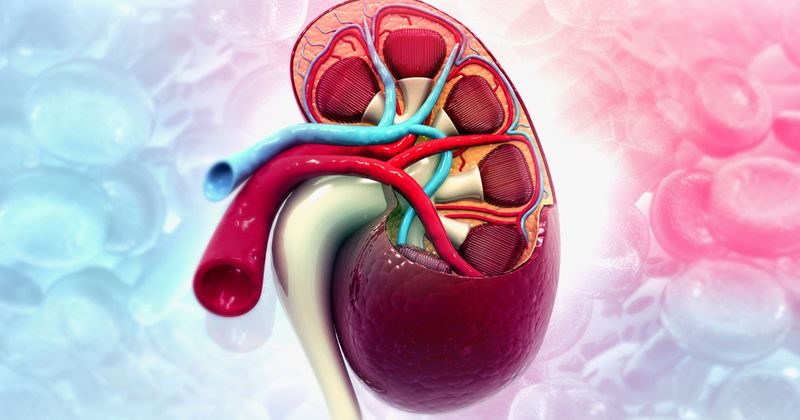Screening for albuminuria may identify candidates for finerenone
BOSTON — Finerenone reduces CV and renal events in patients with type 2 diabetes and chronic kidney disease, and albuminuria is a good screening tool to identify candidates, according to a speaker.
Finerenone (Kerendia, Bayer), a nonsteroidal mineralocorticoid receptor antagonist (MRA), appears to reduce HF hospitalizations and dialysis, which are both predictors of short-term mortality, by approximately one-fifth in that population, Rajiv Agarwal, MD, MS, professor of medicine at Indiana University School of Medicine and staff physician at R.L. Roudebush VA Medical Center in Indianapolis, said during a presentation at the Cardiometabolic Health Congress.

Source: Adobe Stock
To illustrate the point, Agarwal discussed the FIDELITY pooled analysis of patients from the FIDELIO-DKD trial of finerenone, whose primary endpoint was kidney-related, and the FIGARO-DKD trial of finerenone, whose primary endpoint was CV-related, which was conducted to determine whether finerenone added to maximized renin-angiotensin system inhibition reduced CVD and kidney disease progression in patients with type 2 diabetes and a broad range of chronic kidney disease.
All patients had an estimated glomerular filtration rate (eGFR) of at least 25 mL/min/1.73 m2 and serum potassium of 4.8 mmol/L or lower. Urine albumin-creatinine ratio (UACR) ranged from 30 mg/g to 5,000 mg/g, and patients with symptomatic HF with reduced ejection fraction were excluded because those patients are taking steroidal MRAs such as spironolactone or eplerenone, which are level 1A indication for HF hospitalization and all-cause mortality, Agarwal said during the presentation.
The analysis included 6,519 patients assigned finerenone and 6,507 patients assigned placebo (median age, 65 years; 70% men).
The composite CV outcome was time to CV death, nonfatal MI, nonfatal stroke or hospitalization for HF. The composite kidney outcome was time to kidney failure, a sustained decrease in eGFR of at least 57% or renal death.
Of note, Agarwal said, “40% of patients in the finerenone program would not be identified as having kidney disease without the measurement of UACR.”
At a median follow-up of 3 years, finerenone reduced the composite kidney outcome by 23% (HR = 0.77; 95% CI, 0.67-0.88; P = .0002; number needed to treat = 60) and the composite CV outcome by 14% (HR = 0.86; 95% CI, 0.78-0.95; P = .0018; number needed to treat = 46) compared with placebo, he said, noting the relative risk reduction was higher in the kidney outcome, but the absolute risk reduction was higher in the CV outcome.
“In other words, this is a drug to prevent the cardiologist and the nephrologist from getting to the patient; this is a primary care drug to prevent cardiorenal outcomes in people with type 2 diabetes,” he said.
Importantly, Agarwal said, finerenone reduced the risk for end-stage kidney disease, defined as initiation of chronic dialysis for at least 90 days or kidney transplant, by 20% (HR = 0.8; 95% CI, 0.64-0.99; P = .04), and for HF hospitalization by 22% (HR = 0.78; 95% CI, 0.66-0.92; P = .003). He noted that 50% of patients hospitalized for HF die within 5 years and 50% of patients diagnosed with end-stage kidney disease die within 2 years.
“The heart failure outcomes start separating within a few weeks, but the kidney failure outcomes take a while, about a year, to start separating,” Agarwal said. “If I can tell my patient that taking this drug can reduce your relative risk for going on dialysis by one-fifth, that is a big deal.”
He also noted that there were very few hyperkalemia-related discontinuations in the finerenone group (0.66 per 100 patient-years), which adds to existing literature showing that finerenone is much less likely to cause hyperkalemia than spironolactone or eplerenone.
The findings underscore the importance of screening for albuminuria, Agarwal said.
“Albuminuria is on nobody’s screening list,” he said. “We have to screen for albuminuria. It’s more than of academic interest. Finerenone on top of standard care reduces the risk of clinically meaningful CV and kidney outcomes in people with type 2 diabetes over a broad spectrum of kidney disease. Screening for albuminuria to identify this at-risk population is important.”

